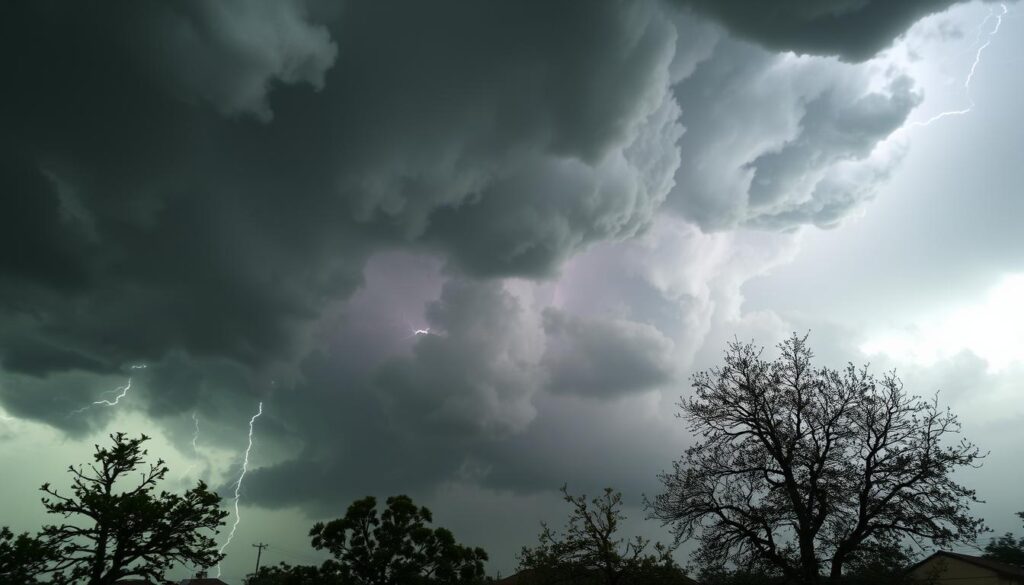Storm Floris

Storm Floris: What You Need to Know
Last year, the UK saw over 50 severe weather events. These events caused a lot of disruption to our daily lives. As Storm Floris gets closer, it’s important to know what dangers it might bring. With strong winds, heavy rain, and a chance of flooding, being ready is key for your safety and the safety of others.
This article will tell you what to expect from Storm Floris. It will also give you important tips on staying safe and how to plan for emergencies. Stay with us for the latest information to help you get through this tough weather.
Key Takeaways
- Storm Floris could bring severe weather, including high winds and heavy rainfall.
- Effective storm preparedness is vital for ensuring safety during natural disasters.
- Emergency response planning can help you react swiftly to changing conditions.
- Understanding the risks of flooding and wind damage is crucial.
- Monitoring weather updates will keep you informed of the situation.
- Community support plays a significant role during and after such events.
Understanding Storm Floris
Storm Floris is a powerful weather system with fast-changing conditions. It’s important to understand how it forms, moves, and affects us. This storm grows over warm ocean waters, where it gets moisture and energy. This leads to heavy rain and strong winds.
The storm’s behaviour is influenced by air pressure and temperature. These factors decide how big and strong the storm will be. Knowing this helps predict where the storm will go and its impact.
Storm Floris can bring heavy rain, flooding, and strong winds. Being aware of these dangers helps us prepare. Staying informed about Storm Floris helps us respond better and stay safe during bad weather.
| Meteorological Factor | Impact on Storm Floris |
|---|---|
| Air Pressure | Low pressure systems draw in moist air, intensifying wind and rain. |
| Temperature | Warmer ocean waters fuel the storm, increasing its strength and potential destruction. |
| Humidity | High humidity levels contribute to heavy precipitation, risking flooding. |
What to Expect During Severe Weather
When severe weather hits, like with Storm Floris, you face tough conditions. Forecasters warn of strong winds, possibly over 60 mph. This can cause trees to fall and buildings to be damaged.
Heavy rain might also lead to flooding, especially in low places. This can really mess up your day.
It’s vital to take safety steps early. Make sure windows and doors are closed to protect your home. It’s safest to stay inside when the storm is at its worst.
Having a plan for emergencies is also key. This should include what to do if the power goes out or if you need to leave. Keep an eye on weather updates to know what’s happening and any warnings from local authorities.
| Weather Condition | Impact | Safety Precautions |
|---|---|---|
| High Wind Gusts | Risk of falling debris and property damage | Secure all outdoor items |
| Heavy Rainfall | Potential for flooding | Avoid low-lying areas; stay indoors |
| Power Outages | Disruption to electricity and communication | Keep a supply of batteries and flashlights |
Storm Floris Alerts and Warnings
It’s vital to stay updated on storm alerts for Storm Floris to keep you safe. The Met Office and emergency teams send out storm warning alerts. These alerts help you understand the storm’s potential impact.
They use colour-coded systems like yellow, amber, and red warnings. A red warning means severe weather that could cause big problems and danger to life. It’s crucial to take these warnings seriously and get ready.
Always check for severe weather updates to stay informed. This helps you prepare quickly for the storm. It ensures you and your family stay safe during the storm.
Storm Preparation: Are You Ready?
Getting ready for Storm Floris is crucial for your safety. It’s about planning and having a strategy for emergencies. Knowing how to make an emergency plan is vital for dealing with severe weather.
Creating an Emergency Response Plan
Begin by making a detailed emergency plan. It should list the steps you’ll take during the storm. Include:
- Evacuation routes: Find safe paths to leave if needed.
- Emergency contacts: Keep family, friends, and local authorities’ numbers handy.
- Designated meeting points: Pick safe spots to meet if you get lost.
Make sure to review and practice this plan with your family. This way, everyone knows what to do in an emergency. Update the plan when family situations change, like new additions.
Stocking Up on Supplies
Having the right supplies is key for storm readiness. Aim to have enough for at least 72 hours. Don’t forget:
- Non-perishable food
- Water
- First aid kit and medical supplies
- Flashlights and batteries
- Important documents in a waterproof bag
Having these items ready gives you peace of mind. It also helps you handle unexpected situations during Storm Floris. Being well-prepared keeps you and your loved ones safe.
Weather Forecast Updates for Storm Floris
Keeping up with weather forecast updates is key during Storm Floris. The Met Office gives timely and accurate info on the storm’s path and strength. These updates help you track the storm’s progress, keeping you ahead of severe weather.
Meteorologists use top-notch hurricane tracking tech to watch Storm Floris closely. This leads to accurate predictions, helping keep everyone safe. By following updates, you can plan ahead and make smart choices.
Local news and online sites also offer weather updates, giving you different views. Using these sources helps you understand the storm’s path and possible severe weather in your area.
| Source | Update Frequency | Type of Information Provided |
|---|---|---|
| Met Office | Every 3 hours | Storm path, intensity, and safety alerts |
| Local News Channels | Every hour | Community-specific impacts and live updates |
| Weather Apps | As updates occur | Real-time notifications and emergency alerts |
Using these sources keeps you informed and safe during Storm Floris. It helps protect you and your family.
Impact Assessment of Storm Floris
Storm Floris’s impact needs a close look at wind damage and flood risk. Knowing these helps us get ready for what might happen. Authorities do a storm impact assessment to guess the damage and what resources are needed.
Evaluating Wind Damage and Flood Risk
Wind can badly damage buildings, trees, and roads. It might break windows, uproot trees, or cause roofs to collapse. Flooding risks are also high. Places at risk of flooding need a detailed flood risk assessment.
Looking at past rains, how water drains, and past floods helps guess flooding during Storm Floris.
Community Response to Storms
A strong community response is key to reduce storm effects. Local councils, emergency teams, and volunteers work together. They set up ways to tell people about safety and where to find help.
Good community plans can help a lot. They make sure people get the support they need during and after the storm.

| Impact Type | Description | Recommended Action |
|---|---|---|
| Wind Damage | Destruction of structures, trees, and power lines. | Secure loose items outdoors; reinforce roofs. |
| Flood Risk | Potential for flash flooding in vulnerable areas. | Monitor weather updates; prepare for evacuation if necessary. |
| Community Response | Engagement of local councils and rescue teams. | Stay informed; participate in community safety drills. |
Storm Tracking Technology
Storm tracking technology is key to handling severe weather like Storm Floris. Meteorologists use advanced systems to get real-time data. This helps predict storms’ paths and strength. A weather tracking map lets users see this data, showing storm routes and wind speeds.
Modern hurricane tracking tools have changed how we get ready for bad weather. They give forecasts and look at past storms. This helps people and authorities make better safety plans.
With new storm tracking tech, getting accurate info reduces worry during hurricane seasons. Using many data sources makes forecasts more reliable. This is vital when we’re unsure. These tools help communities stay strong against storms, saving lives.
| Storm Tracking Technology | Benefits |
|---|---|
| Weather Tracking Map | Visual representation of storm paths, aiding in real-time decision making. |
| Hurricane Tracking Tools | Provides extensive data, including wind speed and potential impact zones. |
| Satellite Imagery | Delivers high-resolution images for analysing storm development and movement. |
Storm Floris: Safety Precautions to Take
When Storm Floris hits, it’s vital to take the right steps to keep you and your family safe. Knowing and following key storm safety tips can help a lot. Getting ready early means you can stay calm when the storm arrives.
Essential Storm Safety Tips
Here are some important tips for a safe emergency response:
- Avoid travel during the storm to prevent accidents and ensure your safety.
- Stay indoors and secure your home to protect against high winds and flying debris.
- Utilise an emergency supply kit stocked with food, water, and medical supplies.
- Remove any outdoor items that could become projectiles in strong winds.
- Keep informed through reliable news sources and emergency services for the latest updates on the storm’s status.
- Avoid flooded areas as swift currents and hidden dangers may pose threats.
How to Minimise Storm Damage
Protecting your home from severe weather like Storm Floris is crucial. By using storm-proofing techniques, you can make your property less vulnerable. These methods help defend your home against strong winds and flooding.
Implementing Storm-Proofing Techniques
There are many ways to make your home stronger against storms. Each method focuses on different parts of your home to help it withstand the storm better. Here are some good strategies:
- Reinforce your roof: Use stronger shingles or roof ties to stop it from lifting in strong winds.
- Secure outdoor items: Move or tie down furniture, decorations, and other loose items that could be dangerous in strong winds.
- Install drainage systems: Good drainage keeps water away from your home, preventing flooding.
- Upgrade windows and doors: Storm shutters or impact-resistant glass can offer extra protection against wind and debris.
By using these techniques, you can make your property more resilient. This reduces storm damage, saving you money and giving you peace of mind during bad weather.
| Storm-Proofing Technique | Benefit |
|---|---|
| Reinforced Roof | Reduces the risk of roof damage from high winds. |
| Secured Outdoor Items | Prevents items from becoming projectiles during storms. |
| Effective Drainage | Minimises water pooling and potential flooding. |
| Impact-Resistant Windows | Increases protection against broken glass and wind penetration. |

Supporting Your Community During Storms
Storms can really hurt communities, so it’s key to get involved. Helping out in local projects builds strength and helps everyone bounce back after a storm like Storm Floris. By sharing disaster tips, you help make your area safer.
Looking out for those who need help is very important. A little kindness, like visiting the elderly or helping families, brings people together. Local councils help by giving advice and tools to get ready.
Working together as a community helps everyone recover and grow. Talking about what might happen and how to deal with it before a storm is smart. This teamwork makes communities stronger and more united.
Storm Floris Aftermath and Recovery
The storm aftermath will bring big challenges as communities start to recover. Knowing how to fix storm damage helps fix homes and local areas. Getting help for storm recovery through different ways is very useful for dealing with the damage.
Storm Damage Repair Services
Fixing your property after the storm needs special services. These services help with both the building’s safety and the owner’s emotional well-being. Key services include:
- Inspection and assessment of structural integrity
- Roof repairs and replacement
- Water damage mitigation and remediation
- Electrical and plumbing repairs
Working with skilled professionals ensures repairs meet high standards. This helps address safety issues after the storm.
Accessing Storm Recovery Assistance
Getting help for storm recovery is key for communities hit by Storm Floris. Local councils, charities, and government programs offer support. Important resources include:
| Resource Type | Contact Method | Description |
|---|---|---|
| Local Council | Phone or Website | Information on available grants and support services |
| Charitable Organisations | Email or Helpline | Financial assistance and emotional support |
| Government Assistance | Online Applications | Comprehensive aid for larger rebuilding efforts |
Having a good emergency plan helps get to these resources faster. This makes recovery quicker and more effective. With good communication and support, communities can recover well.
Conclusion
Understanding Storm Floris is key to keeping you safe during bad weather. Planning ahead for emergencies helps you act fast when things get tough. Getting the latest weather news lets you prepare for the storm’s effects.
Building strong community ties is also important. When weather gets bad, having each other’s backs is crucial. Working together, we can all get through the storm better.
Putting safety first and being ready for storms is essential. By staying alert and taking the right steps, we all help our community get through disasters like Storm Floris.
FAQ
What is Storm Floris?
Storm Floris is a big weather event hitting parts of the UK. It brings strong winds, heavy rain, and the risk of flooding. It forms over warm ocean waters, leading to intense rain and dangerous conditions.
How can I prepare for Storm Floris?
To prepare, make an emergency plan and stock up on essentials. This includes non-perishable food, water, batteries, and medical supplies. Make sure you have enough for at least 72 hours.
What are the key safety precautions during Storm Floris?
Stay safe by staying indoors during bad weather. Secure windows and doors, and avoid travel. Keep away from flooded areas and check news updates regularly.
What kind of alerts will be issued during Storm Floris?
The Met Office and emergency services will issue alerts. These include yellow, amber, or red warnings. A red warning means extreme weather that poses a big risk.
How can I stay updated on the storm’s progress?
Stay informed with regular updates from the Met Office. Use weather tracking technology like maps and apps to track the storm’s path and intensity.
What should I do in the event of severe flooding?
Avoid driving or walking through floodwaters. Even shallow water can be dangerous. Seek higher ground and follow local authorities’ advice on evacuation and safety.
How does storm tracking technology work?
Storm tracking uses satellite images and data modelling. It forecasts the storm’s path and potential impacts. This technology helps prepare you for the storm’s arrival.
What role does my community play during Storm Floris?
Your community is key in storm preparedness and response. Join local efforts, share resources, and help vulnerable neighbours. This builds resilience and supports recovery.
How can I minimise storm damage to my property?
To protect your property, use storm-proofing techniques. Reinforce roofs, secure outdoor items, and install drainage systems. These steps can reduce damage from wind and floods.
What should I do after Storm Floris has passed?
After the storm, check for damage and seek repair services. Also, look for recovery help from local councils, charities, and government resources. This support aids in rebuilding.








